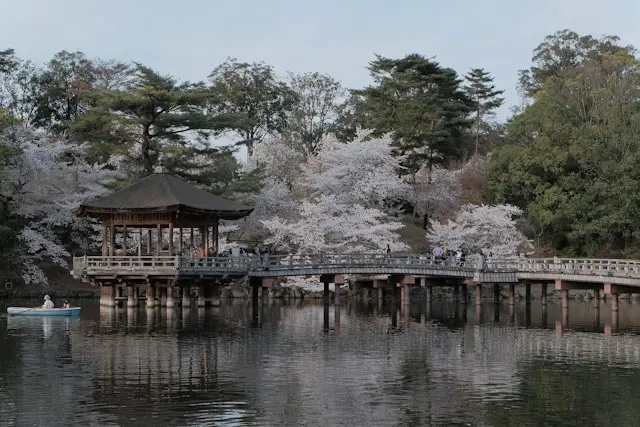
Local Food Recommendations
1. Mimuro Shiratamaya Eiju
When it comes to local specialties in Sakurai, Mimuro is definitely a top choice. With a history of 170 years, it has been passed down through seven generations as a royal confectionery. The name “Mimuro” originally referred to a place where noble people lived or where deities descended, signifying a place of honor. “Mimuro,” the famous sweet, was first made during the Kōka era (1844–1848) by the founder of Shiratamaya Eiju. The name is also derived from the local guardian deity, Miwa Jingu, whose sacred mountain is Miwoyama.
Shiratamaya Eiju, a well-known confectionery shop along the Yamato Kōkaidō road, has become popular nationwide, especially after the development of regional transportation in the Meiji period. It also became a royal gift to the emperor. Mimuro is made from glutinous rice flour, giving it a crispy yet slightly sticky texture, and filled with locally grown Daikoku red beans, giving it a rich, soft, and unique taste.
• Address: 660-1 Miwa, Sakurai, Nara
• Business Hours: Gift Shop 8:00 AM - 7:00 PM, Tea Room 10:00 AM - 6:00 PM
2. Miwa Somen Chaya Senjuttei
Another famous local specialty in Miwa is somen (thin noodles). The history of Miwa somen dates back over 1,200 years. Because the noodles are so thin and require exceptional skill to make, they were once considered a luxury food reserved for high-ranking officials in the imperial court. Only in the Edo period did they become a popular dish for ordinary people. Today, the region still follows traditional methods of making somen, with the thinner noodles being considered of higher quality. Winter is the best time to dry somen, making it a unique winter sight here.
Senjuttei, a restaurant in Miwa, not only offers a gift shop but also has a sophisticated dining area. The menu is diverse, offering traditional cold somen as well as various seasonal hot noodle dishes, like tomato miso soup noodles and burdock and shrimp tempura noodles, all of which are very popular.
• Address: 293 Shiba, Sakurai, Nara
• Business Hours: 11:00 AM - 5:00 PM
Nearby Sightseeing Recommendations
1. Yamabe no Komichi (Mountain Path)
Climbing the Yamabe no Komichi, a mountain path located outside Miwa Mountain, is a fascinating experience. This ancient path, used for communication with neighboring countries, winds through the mountains. The north-south path connects Miwa Mountain in Sakurai to Kasuga Mountain in Nara, and is considered one of Japan’s oldest roads, mentioned in historical records. The typical hiking route is from Sakurai to Tenri, covering approximately 16 kilometers through rice fields and farmland.
2. The Nara-Yamato Four Temple Pilgrimage
The Nara-Yamato Four Temple Pilgrimage refers to Hase-dera, Muro-ji, Okadera, and Abe Monju-in. Historically, Nara-Yamato was known as the birthplace of Japan’s imperial family and has a rich, deep history. The pilgrimage to these temples offers a profound spiritual experience, making it a journey that will leave a lasting impression. Hase-dera and Abe Monju-in are located in Sakurai, while Okadera and Muro-ji are farther away. For the pilgrimage, it’s recommended to visit Okadera, Hase-dera, Abe Monju-in, and Muro-ji in that order.
• Okadera (The Buddha of Good Fortune)
Founded in 663, Okadera, formally known as Ryūgai-ji, is famous for housing Japan’s largest earthen statue of the Buddhist deity Kannon, which dates back to the 8th century. It is considered the oldest site in Japan for disaster prevention, attracting visitors from all over Japan.
• Opening Hours: 8:00 AM - 5:00 PM (March-November), 8:00 AM - 4:30 PM (December-February)
• Admission: Adults 400 yen; Children free
• Address: 806 Oka, Asuka, Takaichi-gun, Nara
• Transportation: Take a bus from Kintetsu Gango-ji Station to Okadera-mae Station.
• Hase-dera (The Compassionate Buddha)
Hase-dera is the head temple of the 3,000 sub-temples in Japan. It has been a sacred site since ancient times and is beautifully described in literary works such as “The Tale of Genji” and “Man’yōshū.” Known as the “Temple of Flowers,” it is a popular pilgrimage site on the Western Japan 33 Temple Pilgrimage.
• Opening Hours: 8:30 AM - 5:00 PM (April-September); 9:00 AM - 4:30 PM (October-March)
• Admission: Adults 500 yen; Children 250 yen
• Address: 731-1 Hase, Sakurai, Nara
• Transportation: 15-minute walk from Kintetsu Hase-dera Station.
• Abe Monju-in (The Buddha of Wisdom)
Established in 645, Abe Monju-in is one of Japan’s oldest temples. The main temple houses a National Treasure statue of the Buddhist deity Monju Bosatsu, who rides a lion and uses a sword to cut away the troubles of those who pray to him, granting wisdom.
• Opening Hours: 9:00 AM - 5:00 PM
• Admission: 1,200 yen for a combined ticket (including tea and sweets); 800 yen for children
• Address: 645 Abe, Sakurai, Nara
• Transportation: 2 km walk southwest from Sakurai Station.
• Muro-ji (The Enlightenment Buddha)
Muro-ji is a well-known temple in the deep mountains of Nara, sometimes referred to as “The Women’s Kōya” because it allows female pilgrims, unlike Kōya-san. The main hall houses a serene statue of Shakyamuni Buddha.
• Opening Hours: 8:30 AM - 5:00 PM (April-November); 9:00 AM - 4:00 PM (December-March)
• Admission: Adults 600 yen; Children 400 yen
• Address: 78 Muro, Uda City, Nara
• Transportation: Take a bus from Kintetsu Muro Station to Muro-ji.
Surrounded by World Heritage sites and National Treasures, Nara, with its 1,300 years of history, is filled with traces of the past. These historical remnants coexist with modern buildings, blending classical and modern street scenes that captivate visitors. Next time you get the chance, be sure to visit Sakurai and experience a journey through the millennia.
